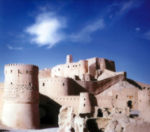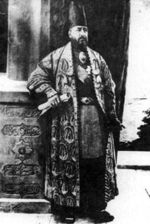Ahvaz (population: 832,969)
The city of Ahvaz, is the capital of the Iranian province of Khuzestan. It is built on the banks of the Karun River and is situated in the middle of Khuzestan Province. The city has an average elevation of 20 meters above sea level.

Iran is the eighteenth largest country in the world after Libya and before Mongolia; Its area roughly equals the size of the United Kingdom, France, Spain, and Germany combined, one-fifth the size of the United States or slightly larger than the state of Alaska. Its borders are with Azerbaijan (432 km/268 mi) and Armenia (35 km/22 mi) to the northwest; the Caspian Sea to the north; Turkmenistan (992 km/616 mi) to the northeast; Pakistan (909 km/565 mi) and Afghanistan (936 km/582 mi) to the east; Turkey (499 km/310 mi) and Iraq (1,458 km/906 mi) to the west; and finally the waters of the Persian Gulf and the Gulf of Oman to the south. Iran's area is 1,648,000 km˛ (approximately 636,300 mi˛ ), of which 1,636,000 km˛ (approx. 631,663 mi˛) is land and 12,000 km˛ (approx. 4,633 mi˛) is water.
Its borders are with Azerbaijan (432 km/268 mi) and Armenia (35 km/22 mi) to the northwest; the Caspian Sea to the north; Turkmenistan (992 km/616 mi) to the northeast; Pakistan (909 km/565 mi) and Afghanistan (936 km/582 mi) to the east; Turkey (499 km/310 mi) and Iraq (1,458 km/906 mi) to the west; and finally the waters of the Persian Gulf and the Gulf of Oman to the south. Iran's area is 1,648,000 km˛ (approximately 636,300 mi˛ ), of which 1,636,000 km˛ (approx. 631,663 mi˛) is land and 12,000 km˛ (approx. 4,633 mi˛) is water.
Science in Iran, as the country itself, has a long history. From the Qanat to the Yakhchal, to the windmill, to the IMOD, Iran has reached scientific achievements and influenced world cultures for thousands of years. Iranians contributed significantly to the current understanding of astronomy, nature, medicine, mathematics, and philosophy. To mention just a few, Persians first invented Algebra and discovered alcohol.
Iran strives to revive the golden age of Persian science. The country has increased its publication output nearly tenfold from 1996 through 2004, and has been ranked first in terms of output growth rate followed by China.
Despite the limitations in funds, facilities, and international collaborations, Iranian scientists remain highly productive in several experimental fields as pharmacology, pharmaceutical chemistry, organic chemistry, and polymer chemistry. Iranian scientists are also helping construct the Compact Muon Solenoid, a detector for CERN's Large Hadron Collider due to come online in 2007.
In the biomedical sciences, Iran's Institute of Biochemistry and Biophysics is a UNESCO chair in biology, and in late 2006, Iranian scientists successfully cloned a sheep by somatic cell nuclear transfer, at the Rouyan research center in Isfahan. Iranian scientists also introduced an herbal drug that may protect those already infected by HIV from the spread of AIDS by strengthening the immune system: "IMOD" was invented by Iranian scientists in 2006, by using nano technology, although its efficacy has been disputed.
The Iranian nuclear program was launched in the 1950s. Iran's current facilities includes several research reactors, a uranium mine, an almost complete commercial nuclear reactor, and uranium processing facilities that include a uranium enrichment plant. The Iranian Space Agency launched its first reconnaissance satellite named Sina-1 in 2006, and a "space rocket" in 2007, which aimed at improving science and research for university students.



 Main articles: Parthian Empire and Seleucid Empire
Parthia was led by the Arsacid dynasty, who reunited and ruled over the Iranian plateau, after defeating the Greek Seleucid Empire, beginning in the late third century BCE, and intermittently controlled Mesopotamia between ca 150 BCE and 224 CE. These were the third native dynasty of ancient Iran (Persia) and lasted five centuries.
Parthia was the arch-enemy of the Roman Empire in the east, limiting Rome's expansion beyond Cappadocia (central Anatolia). By using a heavily-armed and armored cataphract cavalry, and lightly armed but highly-mobile mounted archers, the Parthians "held their own against Rome for almost 300 years".[17] Rome's acclaimed general Mark Antony led a disastrous campaign against the Parthians in 36 BCE in which he lost 32,000 men. By the time of Roman emperor Augustus, Rome and Parthia were settling some of their differences through diplomacy. By this time, Parthia had acquired an assortment of golden eagles, the cherished standards of Rome's legions, captured from Mark Antony, and Crassus, who suffered "a disastrous defeat" at Carrhae in 53 BCE.
Parthian remains display classically Greek influences in some instances and retain their oriental mode in others, a clear expression of "the cultural diversity that characterized Parthian art and life". The Parthians were innovators of many architecture designs such as that of Ctesiphon, which later on "influenced European Romanesque architecture".
Main articles: Parthian Empire and Seleucid Empire
Parthia was led by the Arsacid dynasty, who reunited and ruled over the Iranian plateau, after defeating the Greek Seleucid Empire, beginning in the late third century BCE, and intermittently controlled Mesopotamia between ca 150 BCE and 224 CE. These were the third native dynasty of ancient Iran (Persia) and lasted five centuries.
Parthia was the arch-enemy of the Roman Empire in the east, limiting Rome's expansion beyond Cappadocia (central Anatolia). By using a heavily-armed and armored cataphract cavalry, and lightly armed but highly-mobile mounted archers, the Parthians "held their own against Rome for almost 300 years".[17] Rome's acclaimed general Mark Antony led a disastrous campaign against the Parthians in 36 BCE in which he lost 32,000 men. By the time of Roman emperor Augustus, Rome and Parthia were settling some of their differences through diplomacy. By this time, Parthia had acquired an assortment of golden eagles, the cherished standards of Rome's legions, captured from Mark Antony, and Crassus, who suffered "a disastrous defeat" at Carrhae in 53 BCE.
Parthian remains display classically Greek influences in some instances and retain their oriental mode in others, a clear expression of "the cultural diversity that characterized Parthian art and life". The Parthians were innovators of many architecture designs such as that of Ctesiphon, which later on "influenced European Romanesque architecture".
 The end of the Parthian Empire came in 224 CE, when the empire was loosely organized and the last king was defeated by Ardashir I, one of the empire's vassals. Ardashir I then went on to create the Sassanid Empire. Soon he started reforming the country both economically and militarily.
\The Sassanids established an empire roughly within the frontiers achieved by the Achaemenids, with their capital at Ctesiphon, and called their empire Erânshahr (or Iranshahr, "Dominion of the Aryans", i.e. of Iranians).
The end of the Parthian Empire came in 224 CE, when the empire was loosely organized and the last king was defeated by Ardashir I, one of the empire's vassals. Ardashir I then went on to create the Sassanid Empire. Soon he started reforming the country both economically and militarily.
\The Sassanids established an empire roughly within the frontiers achieved by the Achaemenids, with their capital at Ctesiphon, and called their empire Erânshahr (or Iranshahr, "Dominion of the Aryans", i.e. of Iranians). During their reign, Sassanid battles with the Roman Empire caused such pessimism in Rome that the historian Cassius Dio wrote:
“ Here was a source of great fear to us. So formidable does the Sassanid king seem to our eastern legions, that some are liable to go over to him, and others are unwilling to fight at all."
”
The Romans suffered repeated losses particularly by Ardashir I, Shapur I, and Shapur II. During this period the religion of Mithraism as restructured by Prophet Zoroaster, was practiced throughout the Roman Empire and became particularly popular among Roman Soldiers.
Under the Sassanids, Persia expanded relations with China, the arts, music, and architecture greatly flourished, and centers such as the School of Nisibis and Academy of Gundishapur became world renowned centers of science and scholarship.
After roughly six hundred years of confrontation and rivalry with the Roman Empire, raids from the Arab peninsula began attacking the Sassanin and Byzantine frontiers in which a war-exhausted Persia was defeated in the Battle of al-Qâdisiyah, paving way for the Islamic conquest of Persia.
During their reign, Sassanid battles with the Roman Empire caused such pessimism in Rome that the historian Cassius Dio wrote:
“ Here was a source of great fear to us. So formidable does the Sassanid king seem to our eastern legions, that some are liable to go over to him, and others are unwilling to fight at all."
”
The Romans suffered repeated losses particularly by Ardashir I, Shapur I, and Shapur II. During this period the religion of Mithraism as restructured by Prophet Zoroaster, was practiced throughout the Roman Empire and became particularly popular among Roman Soldiers.
Under the Sassanids, Persia expanded relations with China, the arts, music, and architecture greatly flourished, and centers such as the School of Nisibis and Academy of Gundishapur became world renowned centers of science and scholarship.
After roughly six hundred years of confrontation and rivalry with the Roman Empire, raids from the Arab peninsula began attacking the Sassanin and Byzantine frontiers in which a war-exhausted Persia was defeated in the Battle of al-Qâdisiyah, paving way for the Islamic conquest of Persia.





